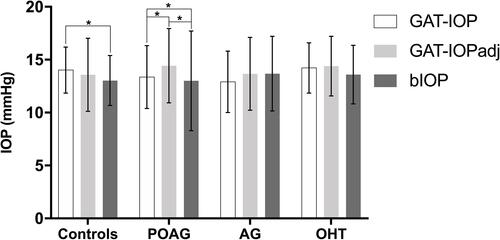Figures & data
Table 1 Demographic and Baseline Characteristics of the Study Groups
Table 2 The Mean Values and Mixed Linear Model (Control Group Set as Reference) for Corvis ST Parameters Adjusted for Age, Gender, GAT-IOP, and Prostaglandin Analogue Medication
Table 3 Mixed Linear Model (Primary Open-Angle Glaucoma Group Set as Reference) for Corvis ST Parameters Adjusted for Age, Gender, GAT-IOP, and Prostaglandin Analogue Medication
Table 4 Mixed Linear Model (Amyloidotic Glaucoma Group Set as Reference) for Corvis ST Parameters Adjusted for Age, Gender, GAT-IOP, and Prostaglandin Analogue Medication
Figure 1 The mean values of intraocular pressure (IOP) obtained by Goldmann applanation tonometry (GAT-IOP), GAT-IOP corrected for pachymetry (GAT-IOPadj), and biomechanically corrected IOP (bIOP) in study groups: control group, primary open-angle glaucoma (POAG) group, amyloidotic glaucoma (AG) group, and ocular hypertension (OHT) group. *p<0.05.

